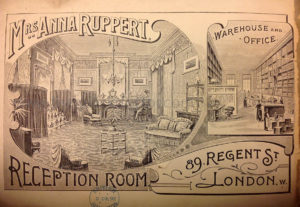Source: The Graphic, Sat 23 August 1879
Laxora was introduced to Britain by its French proprietor, P. Guyot, in 1877, and at once attracted positive attention from the medical press. It sounds a pleasant medicine to take – The Medical Times and Gazette described it thus:
They consist of a core, or centre-part, of compound of manna, cassia-pulp, and other like laxatives, we believe, enclosed in a crystalline chocolate crust; are not at all unpleasant to the taste, and will, we doubt not, be readily taken by children as well as by adults.
Certainly more appealing than the Rectal Dilators or the Aperitive Vase!
In the 18th century, William Buchan (Domestic Medicine), had said that constipation ‘may proceed from drinking rough red wines, or other astringent liquors: too much exercise, especially on horseback,’ but by the mid-19th century many medical writers (particularly in the US) were putting it down to the sufferer not getting into the habit of ‘going to stool’ every day. You had to be regular, and if you weren’t, it was advisable to go anyway, and sit and wait until something happened. Thomas Hawkes Tanner in 1866 estimated that the normal output of a ‘properly fed man’ should be 4 or 5 oz daily. For those with time to kill, Samuel Sheldon Fitch advised:
Let the costive person, exactly at the same time every day, solicit an evacuation, and that most perseveringly for at least one hour, should he not succeed sooner, at the same time leaving off all medicine.
Should the costive person fail at their solicitation, there were numerous remedies to be introduced – by mouth or otherwise. Rhubarb and castor oil were well-known as purgatives, and clysters of castor oil, lukewarm water or, more drastically, tobacco-smoke (as advocated by Thomas Sydenham two centuries earlier) might do the trick. One recipe for a clyster comprised castor oil, turpentine and half a pint of gruel, which I imagine went a long way. If the condition proved stubborn, one US writer said:
When the feces are impacted in the rectum, the assistance of the finger, a scoop, spoon-handle, or some similar instrument, introduced per anum, becomes necessary to break up and discharge the solid mass.
More unusually, an 1854 book by James Smellie described the action of galvanic apparatus as an aid to getting the bowels moving – the positive electrode was to be placed in the lumbar region, the negative to the rectum. With extreme cases, it was necessary to ‘employ the galvanic friction, and sometimes to draw sparks from individual points.’
The emphasis on being regular makes it debatable whether all supposed sufferers really had a problem. ‘Costiveness’ could be diagnosed – and treated quite aggressively – just on the strength of the patient not having defecated for a couple of days, which is hardly a medical emergency.
Ultimately, however, much constipation advice focused on diet, for prevention as well as cure. Strong coffee, too much white bread, especially that contaminated with alum, and the fashionable habit of over-indulging at one late meal rather than eating little and often, were all thought to contribute to the condition. Thankfully for patients daunted by the more drastic remedies, there was the option of beef tea, figs, prunes and tamarinds, molasses, porridge, and plenty of fresh fruit.




Top blog again. I think the ciggy smoke could very well work. I used to smoke and that first one of the day always had the ‘effect’..
Agreed. I was also a smoker, and it was strange, but that’s what it did.
Interesting how some things are still in use today. Such as eating fresh fruit and prunes.
Also advice not to eat a heavy meal late and eating little and often can be found in modern diet books!
Glad that spoon thing is still not in use, though, heh.
And re comment above…ciggies? Not a smoker, so will never know 🙂
I absolutely love the name of this remedy! They really were quite creative with names back then.
Yes, that spoon thing is a bit eye-watering!
Another remedy in use both then and today was senna.